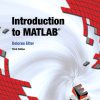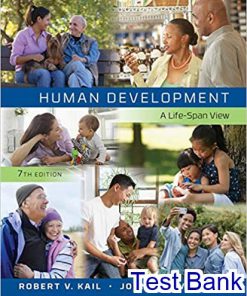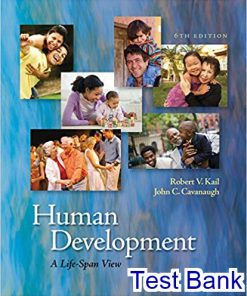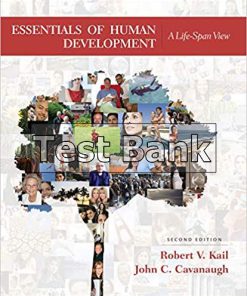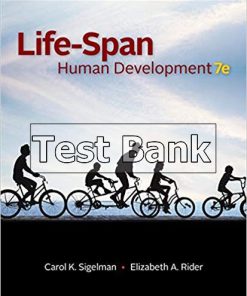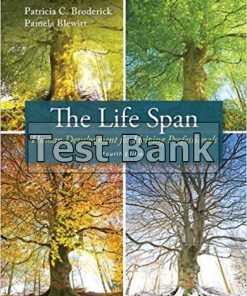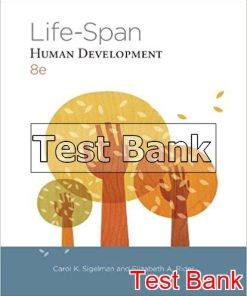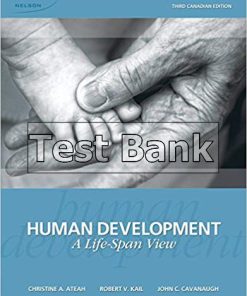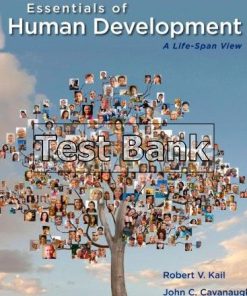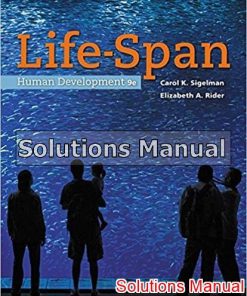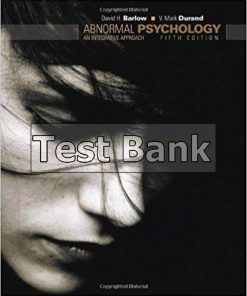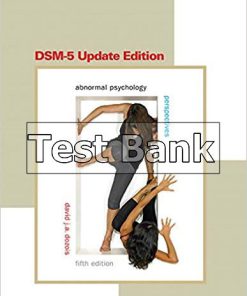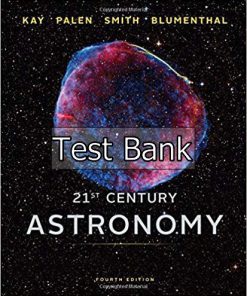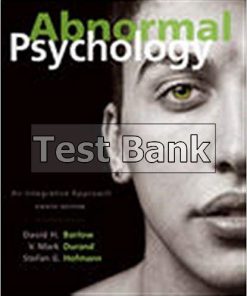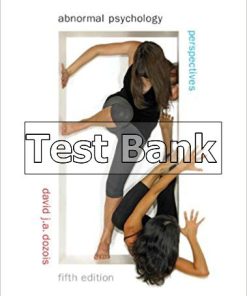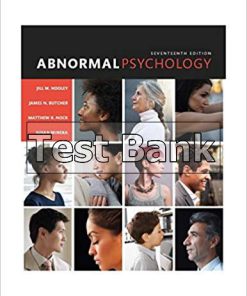Life Span Human Development 9th Edition Sigelman Test Bank
$50.00 Original price was: $50.00.$26.50Current price is: $26.50.
Life Span Human Development 9th Edition Sigelman Test Bank.
This is completed downloadable of Life Span Human Development 9th Edition Sigelman Test Bank
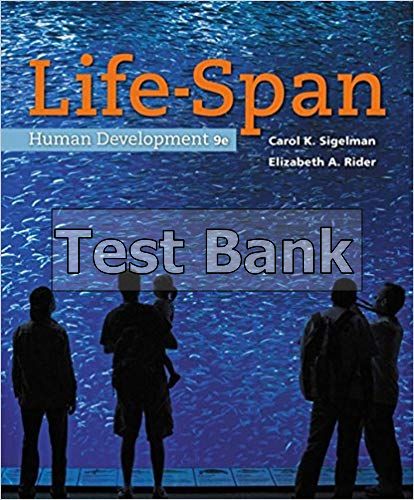
Product Details:
- ISBN-10 : 1337100730
- ISBN-13 : 978-1337100731
- Author: Carol K. Sigelman, Elizabeth A. Rider
Known for its clear, straightforward writing style, grounding in current research, and well-chosen visuals and examples, Sigelman and Rider’s text combines a topical organization at the chapter level and an age/stage organization within each chapter. Each chapter focuses on a domain of development such as physical growth, cognition, or personality and traces developmental trends and influences in that domain from infancy to old age. Each chapter also includes sections on infancy, childhood, adolescence, and adulthood. The organization helps you grasp key transformations that occur in each period of the life span. Other staples of the text are its emphasis on theories and their application to different aspects of development and its focus on the interplay of nature and nurture in development. This edition includes new research on biological and sociocultural influences on life-span development and offers new media resources that help you engage more actively with the content.
Table of Content:
- Chapter 1: Understanding Life-Span Human Development
- 1.1 How Should We Think about Development?
- Defining Development
- Conceptualizing the Life Span
- Framing the Nature–Nurture Issue
- 1.2 What Is the Science of Life-Span Development?
- Goals and Uses of Studying Development
- Early Beginnings
- The Modern Life-Span Perspective
- Exploration 1.1 Growing Up Online
- 1.3 How Is Development Studied?
- The Scientific Method
- Sample Selection
- Data Collection
- The Case Study, Experimental, and Correlational Methods
- Exploration 1.2 Data Collection Methods in Action: Measuring Anger
- Developmental Research Designs
- Exploration 1.3 Millennials and Boomers: Cohort Effects
- Engagement 1.1 Recognizing Research Strategies
- 1.4 What Special Challenges Do Developmental Scientists Face?
- Conducting Culturally Sensitive Research
- Protecting the Rights of Research Participants
- Chapter Summary
- Key Terms
- Chapter 2: Theories of Human Development
- 2.1 Developmental Theories and the Issues They Raise
- Nature–Nurture
- Engagement 2.1 Where Do You Stand on Major Developmental Issues?
- Activity–Passivity
- Continuity–Discontinuity
- Universality–Context Specificity
- 2.2 Psychoanalytic Theory
- Freud’s Legacy
- Exploration 2.1 Freud and Erikson: Notes on Sexual Risk Behavior
- Erikson’s Psychosocial Theory
- Strengths and Weaknesses
- 2.3 Learning Theories
- Watson: Classical Conditioning
- Skinner: Operant Conditioning
- Bandura: Social Cognitive Theory
- Exploration 2.2 Learning Theorists: Notes on Sexual Risk Behavior
- Strengths and Weaknesses
- 2.4 Piaget: Cognitive Developmental Theory
- Constructivism
- Stages of Cognitive Development
- Strengths and Weaknesses
- Exploration 2.3 Piaget: Notes on Sexual Risk Behavior
- Other Perspectives on Cognitive Development
- 2.5 Systems Theories
- Bronfenbrenner’s Bioecological Model
- Strengths and Weaknesses
- Exploration 2.4 Bronfenbrenner: Notes on Sexual Risk Behavior
- 2.6 Theories in Perspective
- Application 2.1 Using Developmental Theories to Reduce Sexual Risk Behavior among Teens
- Chapter Summary
- Key Terms
- Chapter 3: Genes, Environment, and Development
- 3.1 Evolution and Species Heredity
- Engagement 3.1 Genetic Influence: What is Myth, What is Reality?
- 3.2 Individual Heredity
- The Genetic Code
- From Genotype to Phenotype
- Mechanisms of Inheritance
- Mutations
- Copy Number Variations
- Chromosome Abnormalities
- Genetic Diseases and their Diagnosis
- Application 3.1 Prenatal Detection of Abnormalities
- 3.3 Studying Genetic and Environmental Influences
- Twin, Adoption, and Family Studies
- Estimating Influences
- Molecular Genetics
- 3.4 Selected Behavioral Genetics Findings
- Intellectual Abilities
- Temperament and Personality
- Psychological Disorders
- The Heritability of Different Traits
- 3.5 Gene–Environment Interplay
- Gene–Environment Interactions
- Gene–Environment Correlations
- Exploration 3.1 Differential Susceptibility: Orchids and Dandelions
- Epigenetic Effects on Gene Expression
- Controversies Surrounding Genetic Research
- Chapter Summary
- Key Terms
- Chapter 4: Prenatal Development and Birth 89
- 4.1 Prenatal Development
- Conception
- Prenatal Stages
- 4.2 The Prenatal Environment and Fetal Programming
- Teratogens
- The Mother’s State
- Application 4.1 Growing Healthier Babies
- The Father’s State
- Engagement 4.1 Understanding Effects of Teratogens
- 4.3 The Perinatal Environment
- Possible Hazards
- The Mother’s Experience
- The Father’s Experience
- 4.4 The Neonatal Environment
- Breast or Bottle?
- Identifying At-Risk Newborns
- Risk and Resilience
- Exploration 4.1 Skills for Parenting Tiny Babies
- Chapter Summary
- Key Terms
- Chapter 5: Body, Brain, and Health
- 5.1 Building Blocks of Growth and Lifelong Health
- The Endocrine System
- The Brain and Nervous System
- Principles of Growth
- A Life-Span Developmental Model of Health
- 5.2 The Infant
- Rapid Growth
- Newborn Capabilities
- Health and Wellness
- 5.3 The Child
- Brain Lateralization
- Physical Behavior
- Health and Wellness
- 5.4 The Adolescent
- The Adolescent Brain: What’s Going On in There?
- The Growth Spurt
- Sexual Maturation
- Exploration 5.1 Sports and Brain Damage
- Health and Wellness
- 5.5 The Adult
- The Changing Brain
- The Changing Reproductive System
- Health and Wellness
- Theories of Aging: Why Do We Age and Die?
- Exploration 5.2 Want to Live to Be 100?
- Successful Aging
- Chapter Summary
- Key Terms
- Chapter 6: Sensation, Perception, and Action
- 6.1 Perspectives on Perception
- 6.2 The Infant
- Vision
- Hearing
- Application 6.1 Aiding Infants and Children with Hearing Impairments
- The Chemical Senses: Taste and Smell
- The Somaesthetic Senses
- Influences on Early Perceptual Development
- 6.3 The Child
- Locomotion: The Coupling of Perception and Action
- Exploration 6.1 Grasping and Reaching
- Integrating Sensory Information
- Advances in Attention
- 6.4 The Adolescent
- Attention
- Hearing
- Another Look at the Chemical Senses
- Engagement 6.1 Are You a Supertaster?
- 6.5 The Adult
- Vision
- Hearing
- Exploration 6.2 Aging Drivers
- Aging of the Chemical Senses
- Application 6.2 Aiding Adults with Hearing Impairments
- Changes in the Somaesthetic Senses
- The Adult in Perspective
- Chapter Summary
- Key Terms
- Chapter 7: Cognition
- 7.1 Piaget’s Constructivist Approach
- What Is Intelligence?
- How Does Intelligence Develop?
- Piaget’s Contributions
- Challenges to Piaget
- A Modern Take on Constructivism
- 7.2 Vygotsky’s Sociocultural Perspective
- Culture and Thought
- Social Interaction and Thought
- Tools of Thought
- Evaluation of Vygotsky
- Application 7.1 Improving Cognitive Functioning
- 7.3 Fischer’s Dynamic Skill Framework
- Comparison to Piaget and Vygotsky
- 7.4 The Infant
- The Development of Object Permanence
- The Emergence of Symbols
- 7.5 The Child
- Preschoolers: Symbolic Thinking
- Exploration 7.1 Can There Really Be a Santa Claus?
- Elementary-Aged Children: Logical Thinking
- 7.6 The Adolescent
- Emergence of Abstract Thought
- Progress Toward Mastery of Formal Operations
- Engagement 7.1 How Well Do You Understand Piaget’s Stages of Cognitive Development?
- Implications of Formal Thought
- 7.7 The Adult
- Limitations in Adult Cognitive Performance
- Growth Beyond Formal Operations?
- Aging and Cognitive Skills
- Chapter Summary
- Key Terms
- Chapter 8: Memory and Information Processing
- 8.1 Conceptualizing Memory
- Implicit and Explicit Memory
- Neural Bases of Memory
- Problem Solving
- 8.2 The Infant
- Uncovering Evidence of Memory
- Problem Solving
- 8.3 The Child
- Memory Development
- Autobiographical Memory
- Problem Solving
- Application 8.1 Children’s Memory as Eyewitnesses
- 8.4 The Adolescent
- Strategies
- Basic Capacities
- Metamemory and Knowledge Base
- Engagement 8.1 Improve Your Memory!
- 8.5 The Adult
- Developing Expertise
- Autobiographical Memory
- Memory and Aging
- Exploration 8.1 Forgetting: What Is Normal and What Is Not?
- Problem Solving and Aging
- Chapter Summary
- Key Terms
- Chapter 9: Intelligence and Creativity
- 9.1 Defining Intelligence and Creativity
- The Psychometric Approach
- Engagement 9.1 What Do You Know about Intelligence and Creativity?
- Gardner’s Theory of Multiple Intelligences
- Sternberg’s Triarchic Theory and Successful Intelligence
- Creativity
- 9.2 The Infant
- Bayley Scales
- Infant Intelligence as a Predictor of Later Intelligence
- 9.3 The Child
- The Stability of IQ Scores during Childhood
- Causes of Gain and Loss
- The Emergence of Creativity
- 9.4 The Adolescent
- Flynn Effect
- IQ and School Achievement
- Fostering Creativity
- 9.5 The Adult
- IQ and Occupational Success
- IQ and Health
- Exploration 9.1 Intelligent AND Dumb?
- Changes in IQ with Age
- Predictors of Decline
- Application 9.1 Intelligence Training for Aging Adults
- Potential for Wisdom
- Creative Endeavors
- 9.6 Factors that Influence IQ Scores over the Life Span
- Genes and Environments
- Race and Ethnicity
- 9.7 The Extremes of Intelligence
- Intellectual Disability
- Giftedness
- Integrating Cognitive Perspectives
- Chapter Summary
- Key Terms
- Chapter 10: Language and Education
- 10.1 The System of Language
- Basic Components
- Biology
- Theories: Nature and Nurture
- Exploration 10.1 Language Acquisition among Deaf Children
- 10.2 The Infant
- Mastering Language
- The First Words
- Mastery Motivation
- Early Education
- 10.3 The Child
- Expanding Language Skills
- Achievement Motivation
- Engagement 10.1 What’s Your Motivation Style?
- Learning to Read
- Effective Schools, Effective Learning
- Teacher and School Characteristics
- 10.4 The Adolescent
- Declining Levels of Achievement
- Cross-Cultural Differences
- Pathways to Adulthood
- Exploration 10.2 Combining Work and School
- 10.5 The Adult
- Language
- Achievement Motivation
- Literacy
- Continuing Education
- Application 10.1 What Can Theory and Research Contribute to Education?
- Chapter Summary
- Key Terms
- Chapter 11: Self and Personality
- 11.1 Conceptualizing the Self and Personality
- Basic Concepts
- Theories of Personality
- Engagement 11.1 A Brief Personality Scale
- 11.2 The Infant
- The Emerging Self
- Temperament
- 11.3 The Child
- Elaborating on a Sense of Self
- Self-Esteem
- The Developing Personality
- 11.4 The Adolescent
- Self-Concept
- Engagement 11.2 How Do Self-Conceptions Change with Age?
- Self-Esteem
- Forging an Identity
- 11.5 The Adult
- Self-Concepts and Self-Esteem
- Application 11.1 Combating Negative Stereotypes of Aging
- Continuity and Discontinuity in Personality
- Exploration 11.1 Personality and Culture: The Importance of Fit
- Eriksonian Psychosocial Growth
- Midlife Crisis?
- Vocational Development and Adjustment
- Personality and Successful Aging
- Chapter Summary
- Key Terms
- Chapter 12: Gender Roles and Sexuality
- Engagement 12.1 Test Your Understanding of Sex and Gender
- 12.1 Sex and Gender
- Gender Roles and Stereotypes
- Gender Differences or Similarities?
- 12.2 The Infant
- Differential Treatment
- Early Learning
- The Beginnings of a Sexual Self
- 12.3 The Child
- Acquiring Gender Stereotypes
- Gender-Typed Behavior
- Explaining Gender-Role Development
- Application 12.1 Changing Gender-Role Attitudes and Behavior
- Childhood Sexuality
- Sexual Abuse
- 12.4 The Adolescent
- Adhering to Gender Roles
- Not Adhering to Gender Roles: Transgender Youth
- Attaining Sexual Maturity
- Exploration 12.1 Sexual Assaults on College Campuses
- 12.5 The Adult
- Changes in Gender Roles
- Changes in Sexuality
- Chapter Summary
- Key Terms
- Chapter 13: Social Cognition and Moral Development
- 13.1 Social Cognition
- Developing a Theory of Mind
- Engagement 13.1 Do You Have a Theory of Mind?
- Trait Perception
- Perspective Taking
- Social Cognition in Adulthood
- 13.2 Perspectives on Moral Development
- Moral Emotion: Psychoanalytic Theory and Beyond
- Moral Reasoning: Cognitive-Developmental Theory
- Moral Behavior: Social Learning Theory
- Foundations of Morality: Evolutionary Theory
- 13.3 The Infant
- Empathy, Prosocial Behavior, and Morality
- Antisocial Behavior
- Early Moral Training
- Exploration 13.1 Marshmallows and the Life-Span Significance of Self-Control
- 13.4 The Child
- Moral Understandings
- Moral Socialization
- 13.5 The Adolescent
- Moral Identity
- Changes in Moral Reasoning
- Antisocial Behavior
- Application 13.1 Stopping the Bullies
- 13.6 The Adult
- Changes in Moral Reasoning
- Culture and Morality
- Moral Intuition and Emotion
- Exploration 13.2 Moral Thinking in India
- Engagement 13.2 Runaway Trolleys
- Predicting Moral Action
- Religion and Spirituality
- Chapter Summary
- Key Terms
- Chapter 14: Emotions, Attachment, and Social Relationships
- 14.1 Emotional Development
- First Emotions and Emotion Regulation
- Emotional Learning in Childhood
- Exploration 14.1 Emotion Coaching or Emotion Dismissing?
- Adolescents’ Emotional Lives
- Emotions and Aging
- 14.2 Perspectives on Relationships
- Attachment Theory
- Peers: The Second World of Childhood
- 14.3 The Infant
- An Attachment Forms
- Quality of Attachment
- Implications of Early Attachment
- First Peer Relations
- 14.4 The Child
- Parent–Child Attachments
- Peer Networks
- Play
- Peer Acceptance
- Friendships
- 14.5 The Adolescent
- Attachments to Parents
- Friendships
- Changing Social Networks
- Dating
- Exploration 14.2 Searching for Love as an LGBT Youth
- 14.6 The Adult
- Social Networks
- Romantic Relationships
- Adult Attachment Styles
- Engagement 14.1 Internal Working Models of Attachment
- Adult Relationships and Adult Development
- Application 14.1 Building Secure Attachments
- Exploration 14.3 Lonely Hearts
- Chapter Summary
- Key Terms
- Chapter 15: The Family
- 15.1 Understanding the Family
- The Family as a System within Systems
- Engagement 15.1 Do You Know Today’s American Family?
- The Family as a Changing System
- A Changing System in a Changing World
- 15.2 The Infant
- Mothers and Fathers
- Mothers, Fathers, and Infants: The System at Work
- 15.3 The Child
- Parenting Styles
- Social Class, Economic Hardship, and Parenting
- Exploration 15.1 Culture and the Tiger Mother
- Models of Influence in the Family
- Sibling Relationships
- 15.4 The Adolescent
- Ripples in the Parent–Child Relationship
- Achieving Autonomy
- Exploration 15.2 Helicopter Parents and the Quest for Autonomy
- 15.5 The Adult
- Establishing a Marriage
- New Parenthood
- The Child-Rearing Family
- The Empty Nest
- Grandparenthood
- Changing Family Relationships
- Exploration 15.3 Caring for Aging Parents in China
- 15.6 Diverse Family Experiences
- Singles
- Childless Married Couples
- Gay and Lesbian Families
- Divorcing Families
- Reconstituted Families
- 15.7 The Problem of Family Violence
- Why Does Child Abuse Occur?
- What Are the Impacts of Child Abuse?
- Application 15.1 How Do We Stop the Violence?
- Chapter Summary
- Key Terms
- Chapter 16: Developmental Psychopathology
- 16.1 What Makes Development Abnormal?
- DSM Diagnostic Criteria
- Developmental Psychopathology
- 16.2 The Infant
- Autism Spectrum Disorder
- Depression
- 16.3 The Child
- Externalizing and Internalizing Problems
- Nature and Nurture
- Attention Deficit Hyperactivity Disorder
- Engagement 16.1 Could You Have ADHD?
- Depression
- Application 16.1 How Do You Treat a Depressed 3-Year-Old?
- 16.4 The Adolescent
- Storm and Stress?
- Adolescent Problem Behaviors
- Eating Disorders
- Substance Use Disorders
- Depression and Suicidal Behavior
- Exploration 16.1 Peer Socialization or Peer Selection?
- Engagement 16.2 Is Anyone You Know Suicidal? Know the Warning Signs
- 16.5 The Adult
- Stress and Disorder
- Depression
- Aging and Dementia
- Chapter Summary
- Key Terms
- Chapter 17: The Final Challenge: Death and Dying
- 17.1 Matters of Life and Death
- What Is Death?
- Engagement 17.1 Life and Death Attitudes
- What Kills Us and When?
- 17.2 The Experience of Death
- Perspectives on Dying
- Perspectives on Bereavement
- 17.3 The Infant
- 17.4 The Child
- Grasping the Concept of Death
- The Dying Child
- The Bereaved Child
- 17.5 The Adolescent
- Advanced Understandings of Death
- Experiences with Death
- 17.6 The Adult
- Death in the Family Context
- Exploration 17.1 Bereavement among the Partners of Gay Men with HIV/AIDS
- The Grief Work Perspective and Challenges to It
- Who Copes and Who Succumbs?
- Posttraumatic Growth
- Engagement 17.2 The Bright Side of Bereavement
- 17.7 Taking the Sting Out of Death
- For the Dying
- For the Bereaved
- Taking Our Leave
- Application 17.1 The Family Bereavement Program
- Chapter Summary
- Key Terms
- Appendix Careers in Human Development
- Research
- Teaching
- Professional Practice
- Pre-Bachelor’s or Bachelor’s-Level Positions
- Applied Developmental Psychologist
- Counselor, Psychologist, or Therapist
- Health and Allied Health Professionals
- Other Options
- Resources
- Glossary
- References
- Name Index
- Subject Index
People Also Search:
span human development sigelman
span human development 9th edition sigelman
span human development
span human development 9th edition
span human development 9th edition download scribd
span human development 9th edition testbank download pdf
Instant download after Payment is complete
You may also like…
Solutions Manual
Humanities and Social Sciences
Essentials of Human Development A Life Span View 1st Edition Kail Test Bank
Solutions Manual
Life-Span Human Development 9th Edition Sigelman Solutions Manual


